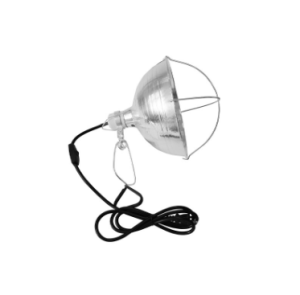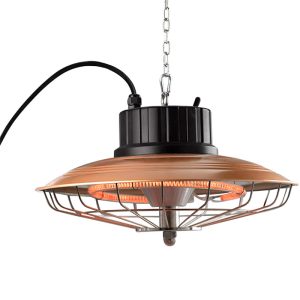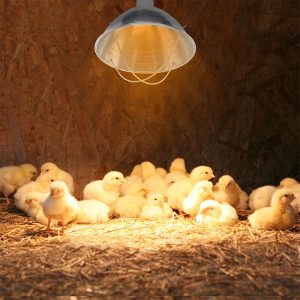The hanging height and density of Brooder Lamps for Chicks must ensure even temperature distribution and complete light coverage, avoiding localized hot or cold spots. Adjustments should be made dynamically based on the lamp type, wattage, rearing system, and the age of the chicks.
I. Hanging Height: Precise Settings by Lamp Type
- Incandescent Lamps: Concentrated heat output requires balancing temperature and burn risk.
- 60W: 1.8-2.2 meters from the ground without a shade; can be raised to 2.5-3.1 meters with a shade.
- 80W: Height should be 10-15 cm higher than the 60W lamp.
- Assessment: Lower the height if chicks huddle and chirp loudly; raise the height if they move away from the lamp and pant.
- Infrared Lamps: Radiant heat, suitable for floor brooding.
- 100W: 1.2-1.5 meters from the ground, creating a warm zone 2-3 meters in diameter.
- 150W: 1.5-1.8 meters from the ground, covering a diameter of 3-4 meters.
- Cage Rearing: Needs to be raised to 1.8-2.0 meters.
- Crucial: Must be equipped with a protective guard and installed vertically.
- LED Brooder Lamps: Good heat dissipation, wide light coverage.
- 30W: 2.1-2.3 meters from the ground, covering 4-6 square meters.
- 50W: 2.3-2.5 meters from the ground, covering 6-8 square meters.
- Advantage: Flexible height adjustment; dimmable function reduces need for frequent height changes.
- Small Specialized Lamps: For quail, button quail, etc.
- 15W: 40-45 cm from the ground, covering a diameter of 1-1.5 meters.
- 25W: 45-50 cm from the ground, covering a diameter of 1.5-2 meters.
- Note: Set up a barrier around the lamp to prevent burns.
II. Density Calculation: Eliminating Hot and Cold Spots
- Basic Coverage Area:
- 60W Incandescent: 3-5 sq m
- 100W Infrared: 4-6 sq m
- 30W LED: 4-6 sq m
- 15W Small Lamp: 1-1.5 sq m
- Calculation Formula: Total Rearing Area ÷ Single Lamp Coverage Area = Number of Lamps (round up)
- Arrangement Pattern: Use a staggered arrangement. Distance between lamps should be about 1.2 times the hanging height, ensuring 10%-15% overlap in coverage.
- Rearing System Differences:
- Floor Rearing: One 60W incandescent lamp per 20-30 chicks
- Cage Rearing: One 60W incandescent lamp per 50-60 chicks
- Backup Lamps: Large-scale operations require 10%-20% backup lamps.
III. Dynamic Adjustment: Based on Age and Season
- Adjustment by Age:
- Days 1-3: Lower height by 5-10 cm, use upper density limit.
- Days 4-14: Restore standard height, use medium density.
- Day 15 onwards: Increase height by 5-10 cm, use lower density limit.
- Adjustment by Season:
- Winter: Lower height by 10-15 cm, increase density by 10%.
- Summer: Increase height by 10-15 cm, decrease density by 10%.
IV. Common Misconceptions
- Lower height does not equal better heat; too low can cause burns.
- Higher density is not better; too many lamps cause heat buildup.
- Avoid tilted lamps causing uneven temperature distribution.
- Do not use the same standards for different lamp types mixed together.
Core Principle: Base adjustments on chick behavior – even distribution, no huddling, no avoidance of the lamp area, and a temperature variation ≤ 2°C indicates the setup is correct. Find the optimal setup through continuous observation and fine-tuning.







